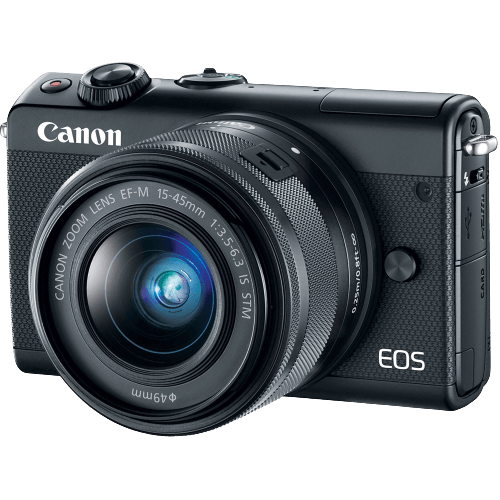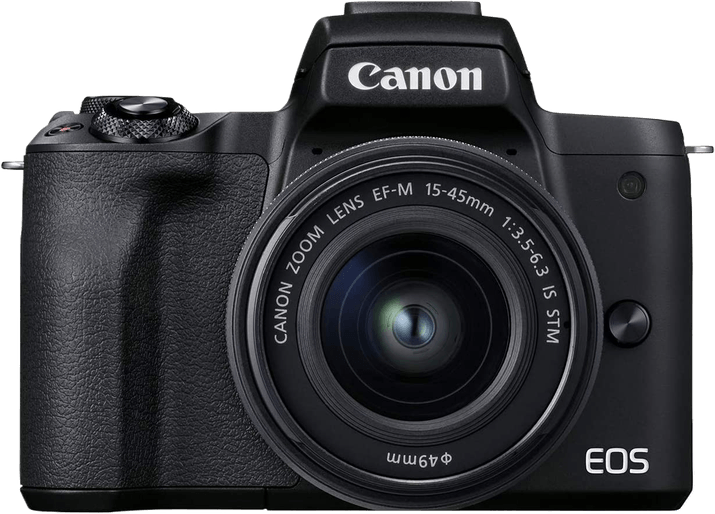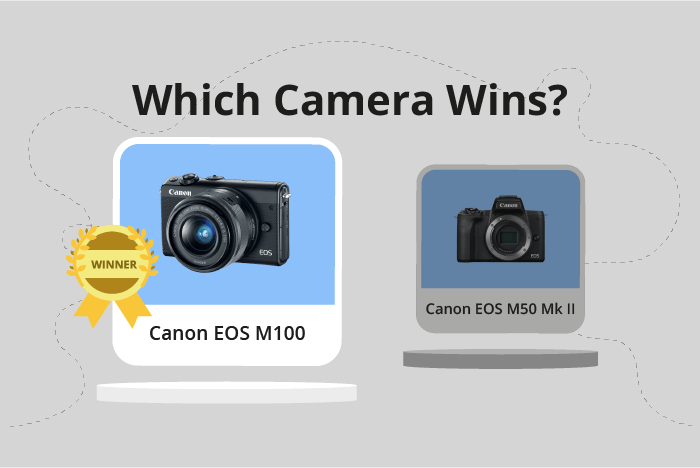Canon EOS M100 vs EOS M50 Mark II Comparison
Canon EOS M100

Canon EOS M50 Mark II

The Canon EOS M100 emerges as the winner with a score of 62/100, outperforming the Canon EOS M50 Mark II, which has a score of 59/100. Both cameras are mirrorless and share similar specifications, such as their type and launch price range ($600 for M100 and $750 for M50 Mark II).
The EOS M100 has its advantages, including a slightly smaller size (108 x 67 x 35mm) and a lighter weight (436g / 0.96lbs) compared to the M50 Mark II (116 x 88 x 59mm, 387g / 0.85lbs). This makes the M100 more portable and convenient for on-the-go photography.
On the other hand, the EOS M50 Mark II, despite its lower score, benefits from a more recent release year (2020) compared to the M100’s 2017 release. This could potentially mean updated features and improvements in the M50 Mark II.
Taking these factors into account, the EOS M100 is a more compact and lightweight option, while the EOS M50 Mark II may offer more up-to-date features. Ultimately, the choice between these cameras depends on the user’s preferences and needs.
Canon EOS M100 vs EOS M50 Mark II Overview and Optics
The Canon EOS M100 surpasses the Canon EOS M50 Mark II in optics, scoring 64/100 compared to the latter’s 59/100. Both cameras share several specifications, including a 24 (M100) and 24.2 (M50 Mark II) megapixel CMOS sensor, APS-C sensor size, Canon EF-M lens mount, and lack of image stabilization.
The EOS M100’s advantage lies in its higher DXOMARK sensor score of 78, compared to the M50 Mark II’s score of 58. This means the M100 has better overall image quality, including superior color depth, dynamic range, and low-light performance. Additionally, the M100 is equipped with a Digic 7 processor, which contributes to its higher score.
In contrast, the EOS M50 Mark II has a faster shooting speed of 10 frames per second, compared to the M100’s 6.1. This makes the M50 Mark II more suitable for capturing fast-moving subjects or action shots. Moreover, the M50 Mark II features a more advanced Digic 8 processor, which can improve processing speed and overall camera performance.
Despite the M100’s higher score in optics, the M50 Mark II’s faster shooting speed and more advanced processor make it a strong contender in certain situations. However, the M100’s superiority in image quality, as evidenced by its higher DXOMARK sensor score, establishes it as the winner in the optics category. Both cameras have their strengths, but for photographers prioritizing image quality, the Canon EOS M100 is the better choice.
Canon EOS M100 vs EOS M50 Mark II Video Performance
The Canon EOS M50 Mark II outperforms the Canon EOS M100 in video capabilities with a video score of 91, which is 21 points higher than the M100’s score of 70. Both cameras share some common features, such as having built-in time-lapse functionality. However, the M50 Mark II boasts superior specifications in terms of video resolution and frame rate.
The M50 Mark II offers a maximum video resolution of 4K (3840 x 2160), which is significantly higher than the M100’s Full HD (1920 x 1080) resolution. This higher resolution allows the M50 Mark II to capture more detailed and sharper videos, making it a better choice for professional videography or for users who prioritize video quality. Additionally, the M50 Mark II has a maximum video frame rate of 120fps, double the M100’s maximum of 60fps. This higher frame rate enables the M50 Mark II to produce smoother slow-motion footage and capture fast-moving subjects with more clarity.
On the other hand, the M100 has limited advantages in its video capabilities compared to the M50 Mark II. The lower video score and specifications make it less suitable for professional videography or users who require high-quality videos. However, it may still be adequate for casual users who prioritize photography over videography and are content with a Full HD resolution.
In comparing the video capabilities of the Canon EOS M100 and the Canon EOS M50 Mark II, the M50 Mark II is the clear winner due to its higher video score and superior specifications. With 4K video resolution and a higher frame rate, it provides better quality videos and is more suitable for professional videography. The M100, while lacking in video capabilities, may still be suitable for casual users who do not require high-quality video performance.
Canon EOS M100 vs EOS M50 Mark II Features and Benefits
The Canon EOS M50 Mark II wins the feature comparison with a score of 91, while the Canon EOS M100 scores 70. Both cameras share several specifications, including a 3-inch screen size, 1,040,000-dot screen resolution, touchscreen capability, flip screen, lack of GPS, and the presence of WiFi and Bluetooth connectivity.
The EOS M50 Mark II outperforms the EOS M100 in several aspects. First, it has a better autofocus system, which ensures faster and more accurate focusing. This feature allows photographers to capture sharp images, even in challenging lighting conditions. Second, the M50 Mark II has a longer battery life, which is essential for extended shooting sessions and travel photography. Third, the M50 Mark II supports 4K video recording, providing higher quality footage than the M100’s 1080p capability.
On the other hand, the EOS M100 has a few advantages over the M50 Mark II. It is lighter and more compact, making it easier to carry around and fit into smaller bags. Additionally, the M100 is slightly more affordable than the M50 Mark II, making it a more budget-friendly option for those who do not require the advanced features of the M50 Mark II.
In the end, the Canon EOS M50 Mark II is the better camera due to its superior autofocus system, longer battery life, and 4K video recording capability. These features make it an ideal choice for photographers who require a high-performance camera for various shooting scenarios. However, the Canon EOS M100 remains a viable option for those seeking a more compact and budget-friendly camera with similar core features.
Canon EOS M100 vs EOS M50 Mark II Storage and Battery
The Canon EOS M50 Mark II outperforms the Canon EOS M100 in storage and battery with a score of 21/100, while the M100 scores 16/100. Both cameras have one memory card slot and accept SD, SDHC, and SDXC (UHS-I compatible) memory cards. They also share the same battery type, LP-E12.
The M50 Mark II has an advantage in battery life, offering 305 shots compared to the M100’s 295 shots. This difference, although not significant, provides a slight edge in favor of the M50 Mark II.
On the other hand, the M100 does not excel in any specific aspect of storage and battery compared to the M50 Mark II. Both cameras lack USB charging capabilities.
Considering the storage and battery aspects, the Canon EOS M50 Mark II is a better choice over the M100, mainly due to its slightly longer battery life. However, the overall difference between the two cameras in this category is minimal.
Canon EOS M100 vs EOS M50 Mark II – Our Verdict
Are you still undecided about which camera is right for you? Have a look at these popular comparisons that feature the Canon EOS M100 or the Canon EOS M50 Mark II:

